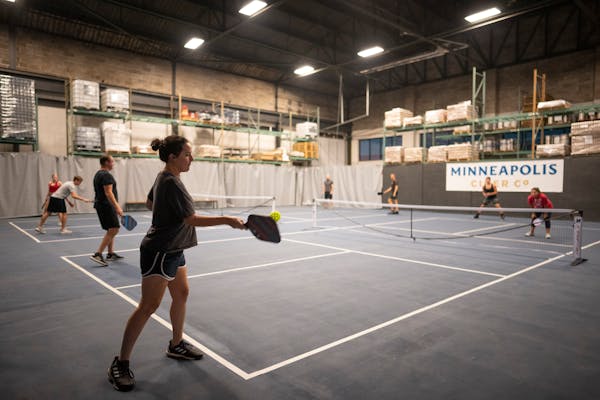First, Sue Schroers broke her shoulder. Then her wrist. And last week a ball hit her in the face.
All injuries thanks to pickleball, a game she's grown to love — and learned not to underestimate — running around the courts in Roseville week after week.
"It was like the third time I had ever played," Schroers said, reflecting on her first injury. "It was kind of a fluky thing. I ended up falling on my shoulder and broke it in three places."
The recreational sport often billed as an accessible combination of tennis, badminton and ping-pong has become hugely popular, especially among older athletes. But with this popularity comes a rising number of doctor visits for sprained ankles, pulled muscles, broken wrists and more. Medical professionals warn that without proper preparation, equipment and safety, even the seemingly gentle pickleball can lead to injuries.
"Give it the due respect that it needs," said Dr. Sanjeev Kakar, a hand and wrist surgeon at Mayo Clinic. "It's a proper sport, and as such, you need to train as if you're playing a proper sport."
Pickleball's popularity has exploded nationwide in recent years, with an estimated 4.8 million U.S. players, according to a 2022 Sports & Fitness Industry Association report cited by USA Pickleball, the sport's national governing body. Of players who play more than seven times a year, the report says more than half are at least 55 years old.
In Minnesota, cities have added dozens of pickleball courts amid increasing demand, and private facilities are popping up, too.
After Schroers, 64, recovered from her shoulder injury, she was back on the court — until she fell backward and landed on her wrist while trying to reach a ball. That was about a year ago. She's since returned to playing regularly with her friends and was ready to jump in with her paddle on a warm Wednesday night in Roseville.
Schroers credits still being able to keep up with pickleball to the care she received at Twin Cities Orthopedics. Physical therapy was a key part in being able to get her full range of motion back in her right shoulder after such a severe break, she said, especially since she holds her paddle in her right hand.
Trent Stensrud, a physical therapist at TRIA, another Twin Cities-area orthopedic clinic, says that he has seen a large increase in patients coming in with injuries from pickleball over the past few years.
A HealthPartners spokesperson said TRIA doesn't have specific data on the number of pickleball injuries.
"The vast majority of pickleball-related injuries are non-surgical and non-invasive," Stensrud said. "For what they need treatment-wise, physical therapy is generally the solution."
Compared to other sports pickleball is relatively safe and low-risk, said Ernie Medinaof USA Pickleball.
Mary Ann Goens-Bradley, who has osteoporosis and is 64, says she doesn't worry any more about getting injured when she plays than she does in daily life.
"I've broken a shoulder, I've broken a wrist, doing other things, just doing everyday things," Goens-Bradley said during a break in play at Northeast Recreation Center in Minneapolis.
"I'm pretty aware of my body's capabilities, and I think that makes a difference too," she said.
Goens-Bradley even bought special pickleball shoes recently, but she said she doesn't feel much of a difference. Pickleball shoes are designed to support the foot when moving in multiple directions, according to Medina.
One of the biggest causes of injury is running backward while playing, which is why USA Pickleball advises against backpedaling in their health and safety guidelines.
Schroers said if she was told earlier that running backward wasn't safe in pickleball, she could have likely prevented her second injury. But even after injuries that are considered to be on the serious side of the pickleball spectrum, she doesn't shy away from the sport.
"You know, I don't feel it's unsafe," Schroers said. "I think people just have to play smart."
Pickleball is an accessible sport, and the rules are easy to understand, but doctors, physical therapists and pickleball experts still emphasize safety.
"It's not necessarily that the sport of pickleball is dangerous," Medina said. "The injuries that we're seeing from pickleball are not from the sport itself so much as people didn't warm up properly in the beginning or they wore the wrong kind of shoes."
Before getting your paddle ready for a game, Mayo Clinic emphasizes remembering the "four P's": proper stretching, proper equipment, proper mechanics and purpose. Practicing purposefully means minimizing time spent doing the same vigorous movements over and over, since many injuries come from overuse, said Kakar, the Mayo Clinic surgeon.
The vast majority of pickleball injuries are not severe, and he said the goal is always to get athletes back on the court as soon as possible.
"I have had many patients that get back to their sport that they love to do," Kakar said.
Ultimately, the risk of injury from pickleball shouldn't stop people from getting on the court, Medina said. He said the benefit of the exercise outweighs the possibility of injury.
"The impact of physical activity that these people are getting compared to the injuries ... there's no comparison," he said.
Charge: Driver going 77 mph ran red light, fatally hit man crossing St. Paul street and kept going
Minnesota Senate GOP files ethics complaint against Sen. Nicole Mitchell
High school archer focuses on target: another national championship

![Mary Ann Goens-Bradley extends herself as she reaches for a ball during a friendly pickup game of pickleball Thursday, Nov. 3, 2022 at the Northeast Recreation Center in Minneapolis. ] ANTHONY SOUFFLE • anthony.souffle@startribune.com](https://arc.stimg.co/startribunemedia/WAMCIWQUKJY37M7EPJEJUTRS5A.jpg?fit=crop&auto=format,compress&cs=tinysrgb&dpr=2&crop=faces&w=525)

